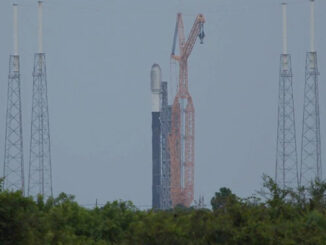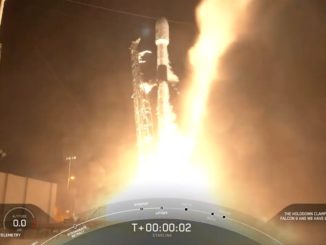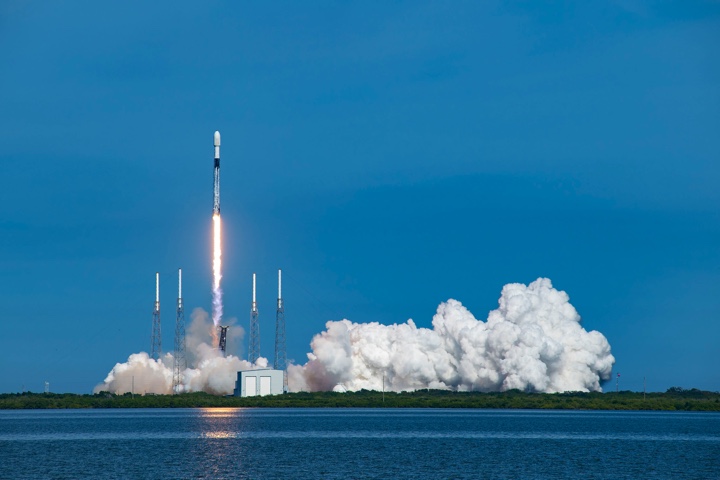
A hefty new satellite to beam SiriusXM radio programming across North America rode a SpaceX Falcon 9 rocket into orbit Sunday from Cape Canaveral on course to replace an aging broadcast station launched more than 15 years ago.
SiriusXM’s SXM 7 spacecraft, built by Maxar in Palo Alto, California, is the first of two new-generation digital broadcasting satellites set to join the company’s fleet in the coming months.
The roughly 15,000-pound (nearly 7 metric ton) satellite lifted off at 12:30 p.m. EST (1730 GMT) Sunday on top of a Falcon 9 rocket from pad 40 at Cape Canaveral Space Force Station in Florida.
Rocketing into the sky on an easterly trajectory from Florida’s Space Coast, the 229-foot-tall (70-meter) Falcon 9 rocket surpassed the speed of sound in about one minute and then let go of its first stage booster more than two-and-a-half minutes into the flight.
Using restarts of its Merlin main engines, the first stage guided itself back to an on-target vertical landing on SpaceX’s drone ship “Just Read the Instructions” positioned several hundred miles east of Cape Canaveral in the Atlantic Ocean. This successful recovery marked the seventh trip to space and back for the SpaceX booster, known as B1051 in the company’s rocket inventory.
Two SpaceX boats were also dispatched downrange to recover the two halves of the Falcon 9’s clamshell-like payload fairing, which jettisoned from the nose of the rocket a few minutes after liftoff.
The Falcon 9’s single-use upper stage, meanwhile, powered into orbit with the SXM 7 satellite. The upper stage’s first burn placed the spacecraft in a preliminary parking orbit, and a restart about 26 minutes into the mission propelled the commercial satellite into an elliptical “sub-synchronous” transfer orbit.
The rocket was targeting an orbit stretching more than 12,000 miles (20,000 kilometers) above Earth at its highest point. SpaceX said the Falcon 9 delivered its satellite passenger to the correct orbit.
A live video stream from the rocket showed the 27-foot-tall (8-meter) SXM 7 spacecraft separating from the Falcon 9’s upper stage over Africa.
Maxar, the spacecraft’s manufacturer, confirmed the satellite was healthy following launch Sunday.
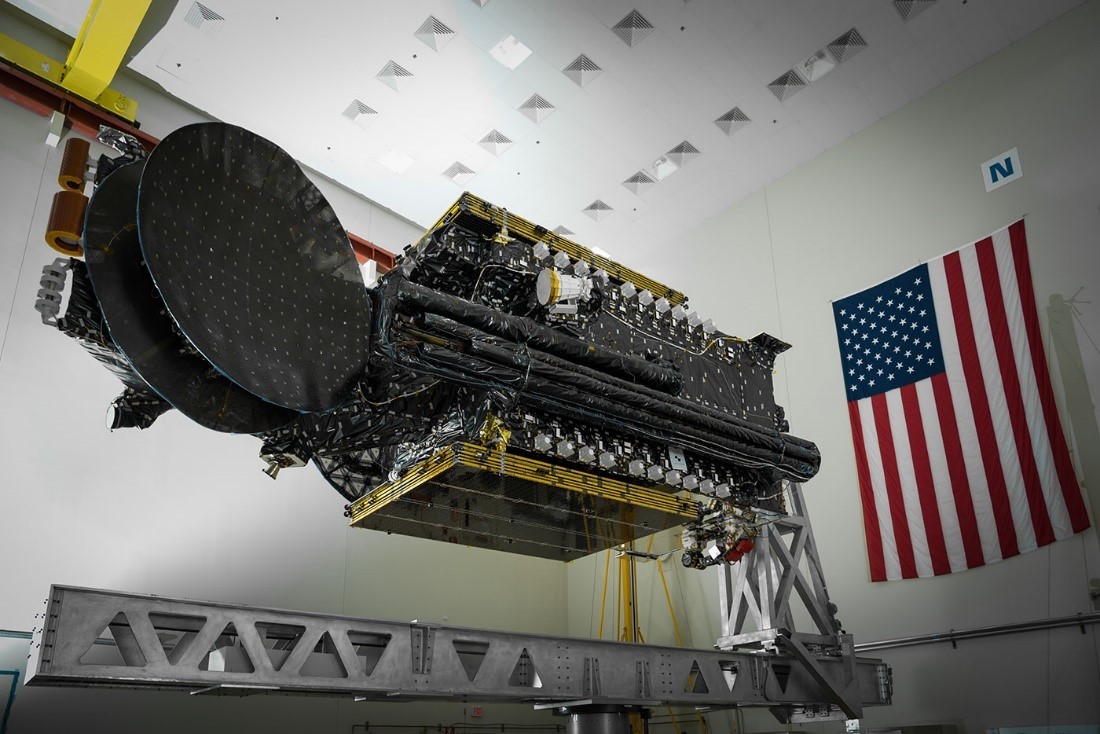
Maxar said the satellite extended its power-generating solar arrays shortly after arriving in space. Ground teams at Maxar also established contact with the satellite as expected.
“Next, SXM 7 will begin firing its thrusters to commence its journey to its final geostationary orbit,” Maxar said.
The maneuvers will boost SXM 7 toward an operational perch in geostationary orbit more than 22,000 miles (nearly 36,000 kilometers). In that orbit, the spacecraft will orbit Earth at the same rate the planet rotates, giving SXM 7 a fixed view of the Americas 24 hours a day, seven days per week.
“The satellite will provide continuous, reliable delivery of SiriusXM’s audio entertainment and information services to consumers in the United States, and will expand SiriusXM’s coverage area in Canada and the Caribbean, for years to come,” SiriusXM saiid in a statement. “SXM 7 will deliver the highest power density of any commercial satellite on orbit, sending more than 8,000 watts of content to the continental U.S., Canada, Puerto Rico, and the Caribbean, increasing the power and reach of the signal for SiriusXM.”
Once in geostationary orbit, the SXM 7 satellite — based on Maxar’s 1300-series spacecraft design — will unfurl a large S-band antenna made reflector made by L3Harris to broadcast radio signals to receivers on moving vehicles.
SXM 7 is expected to replace the XM 3 radio broadcasting satellite at 85 degrees west longitude. The Boeing-built XM 3 satellite launched in 2005 aboard a Sea Launch Zenit 3SL rocket.
The launch of SXM 7 was scheduled earlier this year, but a problem encountered during spacecraft testing at Maxar delayed the mission. SpaceX scrubbed a launch attempt Friday to conduct additional ground system checkouts.
SiriusXM said Sunday it has five satellites in its active fleet, with XM 3 the oldest still operational.
The launch of SXM 7 and a twin satellite named SXM 8 next year — also on a SpaceX Falcon 9 rocket — will extend SiriusXM’s services through at least 2036, the company said in a statement.
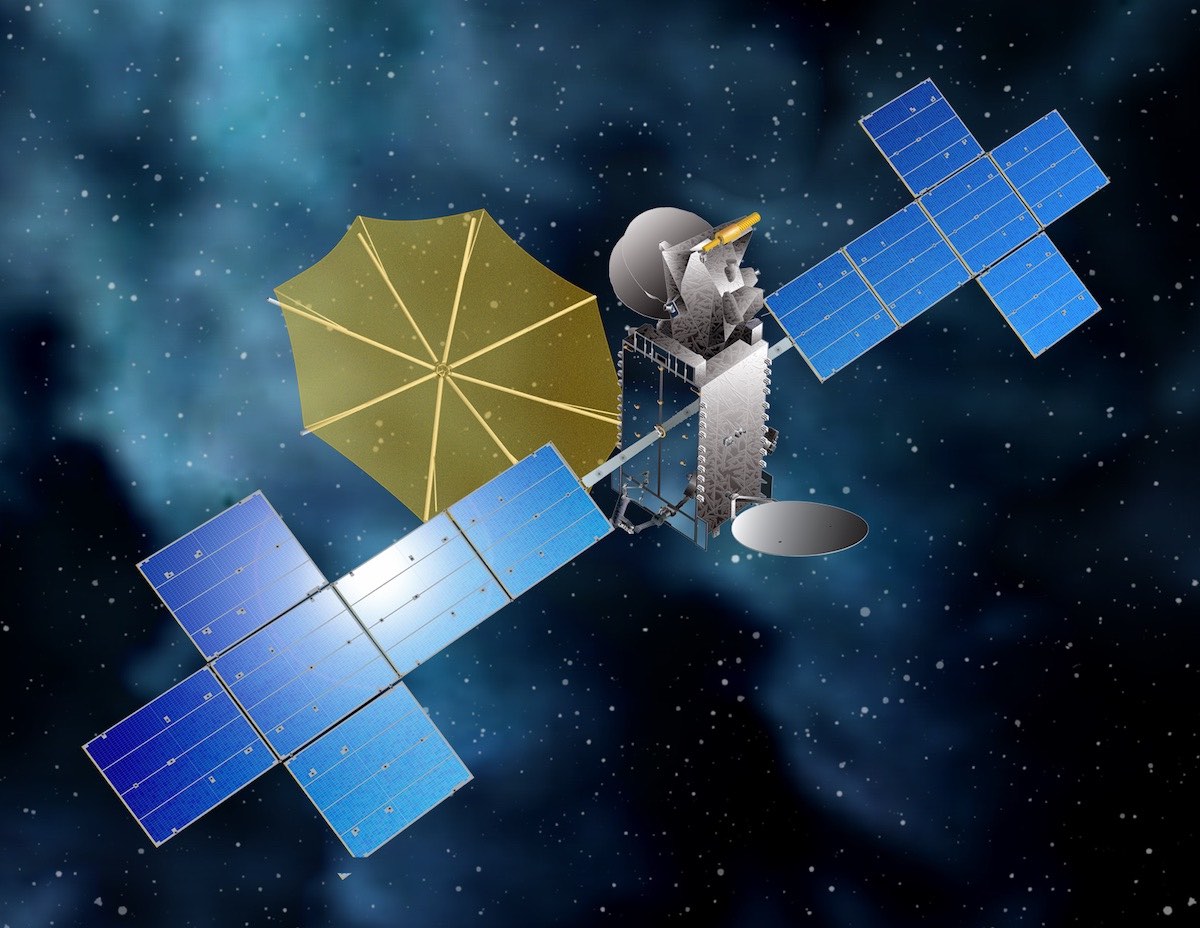
The launch of SiriusXM’s SXM 7 satellite caps a busy week for SpaceX.
On Dec. 6, SpaceX launched its first upgraded Cargo Dragon spacecraft from pad 39A at NASA’s Kennedy Space Center. The automated supply ship — sporting upgrades and a new shape based on SpaceX’s human-rated Crew Dragon capsule — arrived at the International Space Station on Monday, Dec. 7, for a successful docking.
Meanwhile, SpaceX teams in South Texas launched a high-altitude test flight of the company’s next-generation Starship vehicle Wednesday. The 164-foot-tall (50-meter) prototype rocket flew to airliner altitudes powered by methane-fueled Raptor engines, then performed a guided descent back toward a landing pad at SpaceX’s test facility in Boca Chica, Texas, near the U.S.-Mexico border.
The Starship rocket performed a dramatic flip maneuver to set up for landing, but the vehicle erupted in a fireball as it made a crash landing. Elon Musk, SpaceX’s founder and CEO, hailed the test flight as a success.
The reusable Starship could eventually carry more than 100 tons of cargo into space, and transport people to the moon, Mars and other deep space destinations.
With SXM 7’s launch, SpaceX has accomplished 25 successful Falcon 9 missions so far in 2020.
One more launch is left on SpaceX’s schedule this year. A Falcon 9 rocket is set to blast off from pad 39A at NASA’s Kennedy Space Center no earlier than 9 a.m. EST (1400 GMT) Thursday with a classified payload for the National Reconnaissance Office, the U.S. government’s spy satellite agency.
Email the author.
Follow Stephen Clark on Twitter: @StephenClark1.

